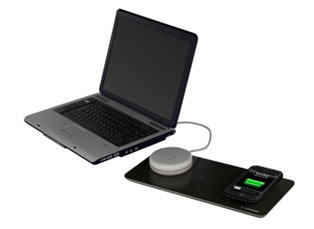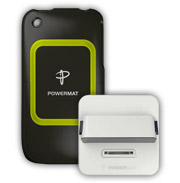CES '09: Charge Portable Devices Without Cords
HoMedics Powermat North America (HPNA) introduced a device that will charge portable applications -such as a cell phone or iPod- without needing to plug them into multiple outlets and power adapters.
But the question is this: just how safe is the device? The Powermat, according to the manufacturer, is based on "principles of magnetic induction," using a unique energy distribution process rather than traditional conductive charging technology. Depending on the model, consumers can place up to six different Powermat-enabled devices on the mat -without inserting any power cords. Each device will recharge as if plugged into its own power adapter. The only plugging taking place is the Powermat's power adaptor connecting to a wall outlet, thereby reducing the overall number of power adaptors and outlets needed.
"Powermat utilizes magnetic induction as a power delivery method, combined with significant IP developed in Israel by Powermat; eliminating the traditional cluster of wires and line cords," says the company. "Powermat offers a ‘complete’ solution with a unique capability to deliver electrical power in either low or high capacity for products as varied as cell phones or laptops. There is no product in the market that can charge both types of devices simultaneously, on the same mat and using a single plug."
As of now, there are five different models to choose from. However, the Powermat's inductive technology pairs an ultra-thin mat with a variety of receivers that connect to the device(s). The mat, an ultra-thin transmitter, transmits a magnetic field generated in an embedded coil matrix to a small, localized receiver attached to or embedded in the electronic device. The power delivery is constantly monitored and regulated by dedicated system resources and data protocol. The Powermat even allows devices to transmit audio and video data wirelessly, allowing users to sync their iPods or transmit videos to the TV "at a very efficient transfer rate."
HPNA aims to take its Powermat one step further in the future, visualizing its device embedded in walls, tabletops or other surfaces, enabling any surface to become an invisible connecting point for wire-free technology. The company claims that its technology is fast, efficient and safe, revolutionizing the way consumers charge and power.
Still, is the device safe? That remains to be seen, especially for consumers with electronic implants such as pacemakers and internal defibrillators. As of this writing, Powermat USA has not responded to our emailed inquiry. A technical white paper issued by HoMedics hints at the products safety by noting that the Powermat is hermetically sealed and has no galvanic contacts.
The Powermat is scheduled to hit store shelves this Fall, and should work on most portable. However HPNA will release a detailed list of compatible devices later this year.
Get Tom's Hardware's best news and in-depth reviews, straight to your inbox.

Kevin Parrish has over a decade of experience as a writer, editor, and product tester. His work focused on computer hardware, networking equipment, smartphones, tablets, gaming consoles, and other internet-connected devices. His work has appeared in Tom's Hardware, Tom's Guide, Maximum PC, Digital Trends, Android Authority, How-To Geek, Lifewire, and others.
-
JonnyDough I guess I still don't see why this is needed. Why not have a universal charging station instead by your computer? I mean, how hard is it to drop a cell phone into a cradle, or move your wireless mouse up on a pad till it connects into a dock? Have we really become this lazy? I'm reminded of the movie "Walle" after reading about this. Forget walking, I want my bed to be able to transport me where ever I want to go by monitoring my eyelid movements. I refuse to exert extra effort by telling my bed where to take me with voice commands.Reply -
1- Expect all your metal pens, glasses, and tie-clips to be sucked to that Powermat! :)Reply
2- They say magnetic radiation (in changing magnetic fields) can cause cancer.
3- It seems like the mat itself is pretty large,and the adaptors (white pads) must be heavy. If not they would vibrate on the mat, and make an annoying sound if the magnetic frequency is too low.
4- I agree with above. Often an AC adaptor and USB cable is provided with these digital 'toys' to charge battery. Why the need for having a third device?
-
I'm looking forward to trying the PowerMat for myself when it comes to market. No more cord clutter - sign me up!Reply
-
This is an interesting concept! I am excited to learn more about the PowerMat when it comes out in the fall.Reply
-
JonnyDough This technology has been in development for awhile. I think we've been hearing about it for a number of years now. At least it's a tech that is coming to fruition. ProDigit you bring up a serious question. We already hit ourselves with electromagnetic radiation from all sides. Cell phones, cords, and anything else that isn't shielded with lead emits cancer onto us. Heck, I don't even like sleeping with my head near a wall outlet. There's iron in your blood. Iron + magnets = slight variations to cells? Who knows. One thing is for sure though, staring at a screen that's emitting radiation all day can have long term detrimental effects on one's eyes.Reply -
zodiacfml it is safer than other wireless power technologies that broadcasts or beams power to device/s.Reply
so, powermat's limitation, to place the device on the mat to charge.
still, we have to wait for devices that has a built-in power receiver. -
undefinedI'm looking forward to trying the PowerMat for myself when it comes to market. No more cord clutter - sign me up!I wouldn't say "no cord"; there still are cords (from the PAD to the computer and the MAT to the poweroutlet).Reply
It's just that they split up the adaptor.
The MAT has a primary adaptor, and the PAD has a secondary adaptor.
I guess systems like that use more electricity than regular adaptors (have a lower efficiency),and the only benefit they would have is that with one Primary Coil you can charge multiple products (which essentially would be the same as buying a powerful adaptor brick, and on the output place a splitter, to charge 2 laptops with the same voltage.
You're still limited by cables; even more, you need to take with you the PAD.
So I don't think this invention is going to get much of anywhere other then perhaps creating cheap childerentoys like a chopperstation with remote chopper. -
The next step?Reply
How about a PowerMat FOR the PowerMat itself, hun?
The sky is the limit, baby... :) -
gm0n3y Nikola Tesla invented a way to power devices remotely over 100 years ago. I can't believe it has taken this long for a product to come to market that does this.Reply -
oddity00 I have to agree with gmOn3y's comment, the forgotten wizard "Nikola Tesla". For his plans of wireless power. But looks like a cool device there, would like to get one :)Reply


